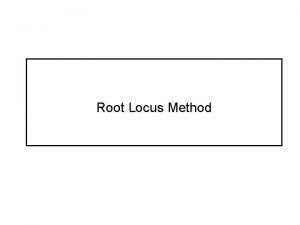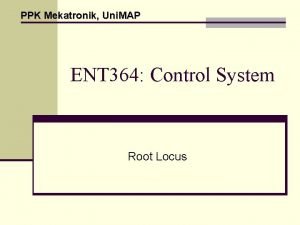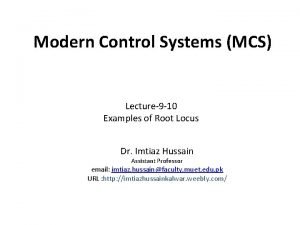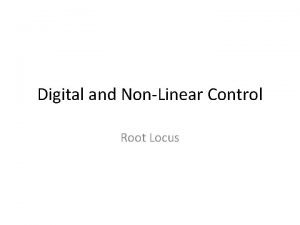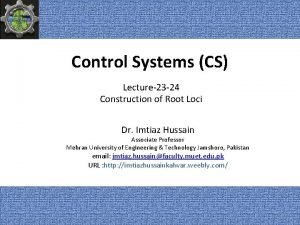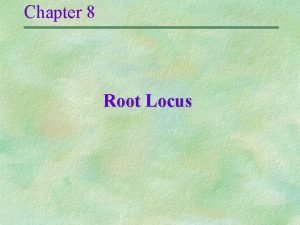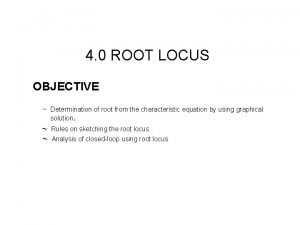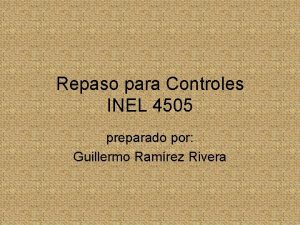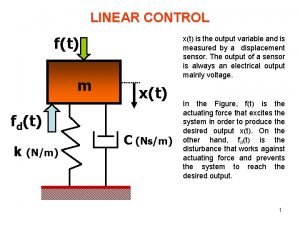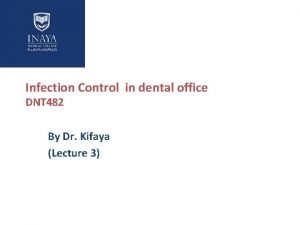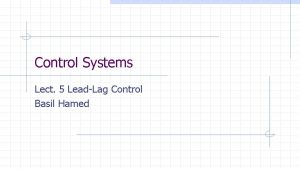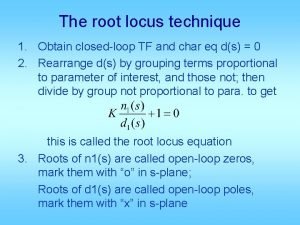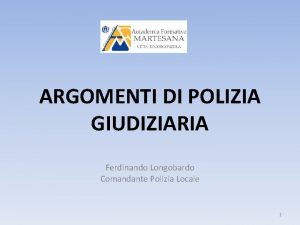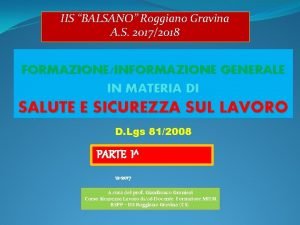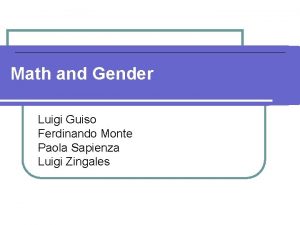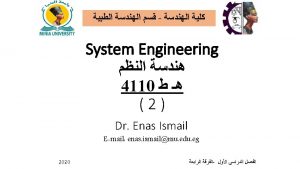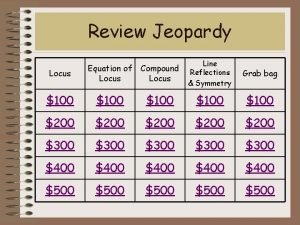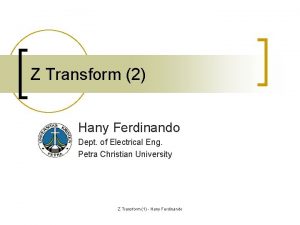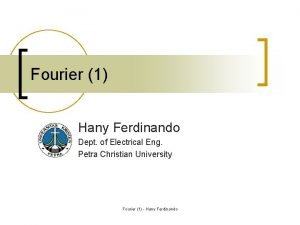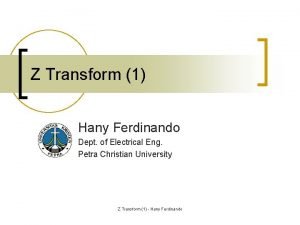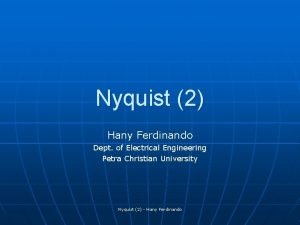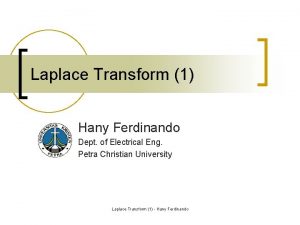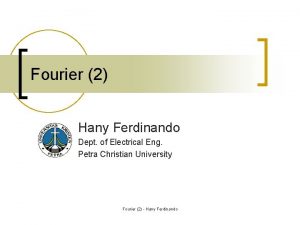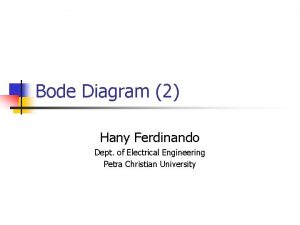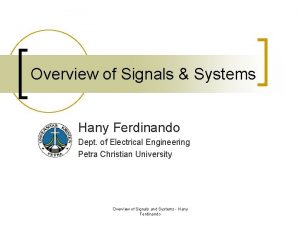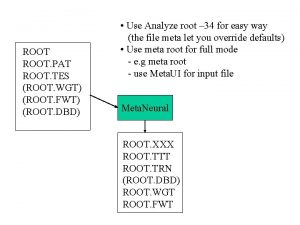Root Locus Analysis 3 Hany Ferdinando Dept of





















- Slides: 21

Root Locus Analysis (3) Hany Ferdinando Dept. of Electrical Eng. Petra Christian University

General Overview Ø This section explain how to use the Root Locus method to design compensator Ø The compensator is lead and lag compensator Ø Students need some basic geometry for precision drawing Ø Pre-requisite: student has to understand how to plot Root Locus in complex plane 2

What is compensator Ø Compensation is the modification of the system dynamic to satisfy the given specification Ø Three compensators: lead, lag and laglead compensator Ø The lag-lead compensator will not be discussed Ø The compensator adds zero and pole to the system 3

Effects of the additional pole Ø It pulls the root locus to the right Ø It tends to lower the system’s relative stability Ø It slows down the settling time 4

Effects of the additional zeros Ø It pulls the root locus to the left Ø It tends to make the system more stable Ø It speeds up the settling time 5

Electrical Compensator 6

Proof that If R 1 C 1 > R 2 C 2 then it is lag network, otherwise it is lead network 7

Lead Compensator (1) Consider s = -1 ± j√ 3 Based on the closed-loop poles, z = 0. 5, wn = 2 rad/s and Static velocity error (Kv) = 2 s-1 Proof it!! 8

Lead Compensator (2) Problem: It is desired to modify the closed-loop poles so that the wn = 4 rad/s without changing the damping ratio z 9

Lead Compensator (3) For the wn = 4 rad/s without changing the damping ratio z, the desired closed-loop poles are inline with the line between the origin and the closed-loop poles of the system s = -2 ± j 2√ 3 10

Lead Compensator (4) If G(s) is the open-loop transfer function, then the open-loop of compensated system is How to find a and T? ? 11

Lead Compensator (5) Desired closed-loop pole A P /2 C B /2 D O PB is the bisector between PA and PO f is the desired angle 12

Lead Compensator (6) Angle of at s = -2+j√ 3 is -210 o Therefore the f is 30 o From the previous slide method, the point C and D is approximately -5. 4 and -2. 9 You can try it by yourself!! 13

Lead Compensator (7) From the previous slide, you can calculate the T, a. T and all Rs and Cs until you get: where K = 4 Kc K = 18. 7916 14

Lead Compensator (8) Compensated open-loop transfer function is with Gc(s) is Find the value for all Rs and Cs in the circuit 15

Lag Compensator (1) Consider s = -0. 3307 ± j 0. 5864 Based on the closed-loop poles, z = 0. 491, wn = 0. 673 rad/s and Static velocity error (Kv) = 0. 53 s-1 Proof it!! 16

Lag Compensator (2) Problem: It is desired to increase the Kv to about 5 s-1 without appreciably changing the location of the dominant closed-loop poles 17

Lag Compensator (3) The new Kv is about 10 times of the old Kv, therefore the b (a in the Lead Compensator) is set to 10. The zero of the compensator is also 10 times of the pole. We get K = 1. 06 Kc 18

Lag Compensator (4) The Root Locus plot of the compensated system is very close to the uncompensated one. Therefore, we need Matlab to help us. The new dominant closed-loop pole with the same z is -0. 31±j 0. 55 (from Matlab). The gain K is 1. 0235 19

Find the pole in complex plane To find the desired dominant complex pole in the Root Locus plot, one can use rlocfind(num, den) function. Output of this function is the selected pole and the gain at that pole. When this function is called, there is a pointer one can use to select a pole in the complex plane. Usually, the Root Locus is drawn first. 20

Next… Bode diagram as a tool for frequency response analysis is the next topic. Prepare yourself for this… 21
 Root locus plotter
Root locus plotter Root locus definition
Root locus definition Ent mekatronik
Ent mekatronik Root locus departure angle
Root locus departure angle Root locus break in point
Root locus break in point What is root locus in control system
What is root locus in control system Angle of arrival root locus
Angle of arrival root locus The locus rule
The locus rule Lag lead compensator in control system
Lag lead compensator in control system Root locus definition
Root locus definition Root locus examples
Root locus examples Root locus drawer
Root locus drawer Hamed
Hamed Root-locus techniques
Root-locus techniques Root-locus techniques
Root-locus techniques Cicatricis
Cicatricis Monje ferdinando facchinei
Monje ferdinando facchinei Ferdinando russo scuola
Ferdinando russo scuola Ferdinando longobardo
Ferdinando longobardo Ferdinando samaria
Ferdinando samaria Iis ferdinando balsano
Iis ferdinando balsano Ferdinando monte
Ferdinando monte

